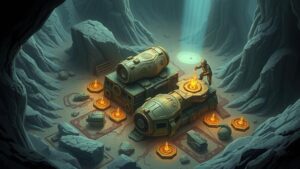Finding and Restoring Old Lockets and Jewelry Using Metal Detectors
Finding and Restoring Old Lockets and Jewelry Using Metal Detectors
The allure of uncovering lost treasures has captivated many, but the process of finding and restoring old jewelry, particularly lockets, presents unique challenges and rewards. Utilizing metal detectors, hobbyists and professionals alike can delve into the earth to discover historically rich artifacts. This article outlines the methodology, tools required, and the restoration process, providing a comprehensive guide for individuals interested in this captivating field.
The Art of Metal Detecting for Jewelry
Metal detecting is not merely about the equipment; it involves an understanding of the environment and historical contexts that could yield valuable finds. Old jewelry, especially lockets, can often be discovered in locations such as:
- Victorian-era parks
- Former homesteads and farms
- Historic battlefields
- Old schools and playgrounds
- Beaches and riverbanks
The choice of location is critical. For example, a study by the National Park Service indicates that many historical parks in the U.S. house artifacts that date back to the early 20th century. Understanding the history of the area can lead to more fruitful searches.
Essential Equipment for Metal Detecting
To begin metal detecting, one must invest in the right equipment. Key tools include:
- Metal Detector: Choose one with discrimination settings to filter out unwanted metals like iron.
- Digging Tools: A small trowel or specific digging knife is essential for careful excavation.
- Headphones: Useful for enhancing sound detection, particularly in noisy environments.
- Finders Utility Tool: A pinpointer can assist in locating smaller finds without extensive digging.
A popular choice among enthusiasts is the Minelab Equinox 800, known for its versatility and depth capabilities. Users report that it effectively detects targets in various soil types, enhancing chances of finding relics.
Restoration of Found Lockets and Jewelry
Finding a locket or piece of jewelry is only the beginning. Restoration involves several steps that require attention to detail and care. Below are critical aspects of the restoration process:
Assessment of the Condition
Once a piece is found, the first step is to assess its condition. Look for:
- Physical damage such as dents or missing stones
- Corrosion or tarnishing, particularly with silver or gold-plated items
- Structural integrity, checking chains or clasps that may need repairs
For example, after finding a Victorian locket that was heavily tarnished, a thorough cleaning revealed intricate designs that had been obscured by layers of grime. Such discoveries can enhance both the aesthetic and historical value of the piece.
Cleaning Techniques
Cleaning old jewelry requires specialized techniques to avoid further damage. Best practices include:
- Using a soft toothbrush and a mixture of mild soap and water to gently clean dirt from engraved areas.
- For tarnished silver, use a baking soda paste; however, limit its use to avoid scratching.
- Professional restoration is recommended for valuable pieces, particularly those requiring soldering or gemstone replacement.
Numerous case studies illustrate that improper cleaning can diminish a pieces value, demonstrating the need for careful handling during restoration.
Preservation and Display
Once restored, preserving the jewelry is the next crucial step. Options for preservation include:
- Storing in acid-free boxes or pouches to prevent tarnishing and moisture damage.
- Displaying in cases that minimize exposure to air and light.
- Regularly checking for signs of wear and addressing issues promptly.
Many collectors recommend using silica gel packets within storage areas to help absorb moisture, thus protecting the integrity of the jewelry over time.
Conclusion: The Joy of Recovery
Finding and restoring old lockets and jewelry using metal detectors can be both an exhilarating hobby and a form of historical preservation. By understanding the process of metal detecting, the necessary tools, restoration techniques, and preservation methods, enthusiasts can genuinely appreciate the art and science behind this captivating pursuit. Remember, each locket discovered is not just a piece of jewelry; it is a connection to the past, with stories waiting to be uncovered. Whether you are a seasoned detectorist or a curious novice, the potential for discovery is vast and filled with wonder.
Actionable Takeaway: For those looking to get started, begin by researching your local area’s history, acquiring suitable equipment, and practicing restoration techniques to enhance your skills. Engage with local metal detecting clubs for additional resources and community support, ensuring a fulfilling and enriching experience.


